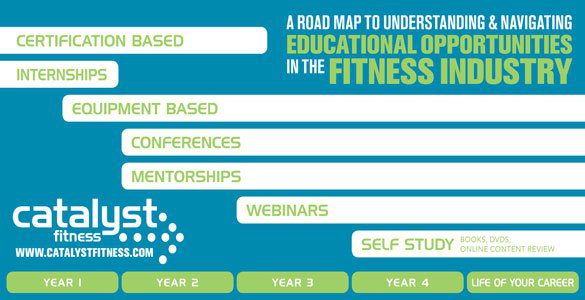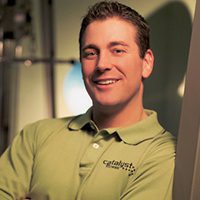As and educator in the health and fitness industry, I meet personal trainer who frequently ask, "what should I complete next in my pursuit of education?"
The purpose of these articles will be broken down into a two-part series which will explain the differences between all the personal trainer educational opportunities stated below. It's important to understand that every proposed formal instruction is a good opportunity to set yourself up for success!
The difference between a "good opportunity" and a "great opportunity" is when and how the personal trainer applies the pursuit of continuing education with the appropriate variables. For example, reading a research article, book, or listening to a lecture on the Krebs Cycle would be premature if the individual was unfamiliar with the concept of the Bioenergetic Continuum (Anaerobic and Aerobic Energy Systems).
The intention behind this example is to edify that learning the foundational principles is a catalyst to understanding details. There's a logical evolution for optimal learning, we as practitioners have a variety of options to choose from, it's the quality and sequence in which we choose that makes the difference and will determine the outcome.
Disclaimer: When weighing the differences with the opportunities we have in education we must consider all attributes. In terms of weighing or measuring the premises of education we often look at Pros/Cons, Strengths/Weaknesses, Positive/Negative, etc. I have ultimately selected "Upside/Downside" when comparing each educational opportunity.
The dilemma is that, in reality, there are all positive reinforcements when it comes to maturing and developing an education, but there are always better choices that exist for that specific instance and moment in time.
There is no difference when choosing an exercise for our client/athlete/patient. Factoring in different principles such as Specificity, Variation, Progression, Individuality, etc. allows us to choose an appropriate exercise for that individual. So with out further ado, buckle your seatbelt...
Your Roadmap
According to Dictionary.com "Education" and "Opportunity" can be defined as:
Education
- The act or process of imparting or acquiring general knowledge developing the powers of reasoning and judgment, and generally of preparing oneself or others intellectually for mature life.
- The act or process of imparting or acquiring particular knowledge or skills, as for a profession.
- A degree, level, or kind of schooling: a university education.
- The result produced by instruction, training, or study: to show one's education.
- The science or art of teaching; pedagogics
Opportunity
- An appropriate or favorable time or occasion.
- A situation or condition favorable for attainment of a goal.
- A good position, chance, or prospect, as for advancement or success.
As my late Maternal Grandfather and Paternal Great Uncle taught me "Opportunity" Occurs When Preparation (Education) and Desire Intersect. Or as Casey Noble, our Director of Training, says when quoting G.I. Joe "Knowing is Half the Battle."
Andy Stanley, our pastor at Buckhead Church, has mentioned on more than one occasion that "we put our money where our passions are".
Where are your passions?
If you're actively seeking information about your passion as a professional personal trainer, the most important prerequisite for determining your level of success as a qualified fitness consultant, as well as your financial success, is through education. Ultimately, your financial freedom enables you to pursue your future passions, even if it's box car racing.
Personal Trainers have 7 Types of Educational Opportunities:
- Certification Based (Exam Prep and Practical Based)
- Internships
- Equipment Based (Put on by Equipment Companies)
- Conferences
- Mentorships
- Webinars
- Self Study (Books, DVD's, Online Content Review)
1) Certification Based courses are those like the ones that ACE (American Council on Exercise) and others offer. (See below for a list of quality U.S. based organizations.) ACE offers the following workshops for personal trainer education (listed directly underneath). The goal of courses like these is generally: to prepare attendees to successfully complete a certification exam, to expand and provide hands-on experience that were not able to be covered reading a book.
Integrated Fitness Training: Effective Tools and Techniques
http://www.acefitness.org/continuingeducation/continuingeducationcoursedetail.aspx?courseid=4a5w3z87
Functional Training
http://www.acefitness.org/continuingeducation/continuingeducationcoursedetail.aspx?courseid=45w32x26
Sports Conditioning
http://www.acefitness.org/continuingeducation/continuingeducationcoursedetail.aspx?courseid=4a5x763y
Small Group Training
http://www.acefitness.org/continuingeducation/continuingeducationcoursedetail.aspx?courseid=4a5zxvvz
I recommend certifications and courses from the following companies in the US.
ACE (American Council on Exercise)
PTA Global (Personal Trainer Academy Global)
NASM (National Academy of Sports Medicine)
NSCA (National Strength and Conditioning Association)
AFPA (American Fitness Professionals and Associates)
ACSM (American College of Sports Medicine)
2) Internships are best suited for individuals that are new to the fitness industry. These personal trainers can be college students or those that are entering the fitness industry as a second career. Regardless of their age or prior life experiences the fact remains that they are green and they need the guidance of a seasoned professional.
Internships are like an Apprenticeship where the Master Craftsman works with a young Pupil to instill and impart their wisdom and techniques. Internships provide a safe and effective way for new Trainers to cut their teeth.
Downside: Generally unpaid or the pay is not very much. As a side note, I find it ironic that people contact professionals wanting to learn from them and then expect to be paid while learning. This would be like expecting a University to pay a student for attending College.
Upside: Interns receive the opportunity to learn in a non threatening and reduced stress environment. Think of it like learning to swim. Internships are like being in the pool with a Lifeguard who is there to teach you. The alternative is being thrown into the deep end, after passing your certification exam, and while desperately thrashing about praying that you don't drown.
The Pilates and Yoga communities have done a much better job than we have at making Internships/Apprenticeships part of the educational and certification process. I feel very strongly that if we want to continue to elevate our profession we need to require Internships be a part of earning a certification. In other words, trainers need more than just book knowledge they need to get their hands and feet wet and develop Practical Skills. From experience, I believe a structured program that consists of 750 hours would be appropriate and sufficient.
3) Equipment Based workshops are generally hands on workshops that involve quite a bit of movement/exercise. Below are my top picks for equipment based courses. If you look at the types of modalities they represent you will see that you get the full spectrum of an Integrated Approach (Flexibility, Core, Balance, Reactive, SAQ, Resistance, Cardio).
Trigger Point Therapy www.tptherapy.com
IndoBoard www.indoboard.com
Redcord www.redcord.us
ViPR www.viprfit.com
CoreFitnessRoller www.corefitnessroller.com
Hyperwear www.hyperwear.com
Dynamax www.medicineballs.com
Halobells www.balancedbells.com
MET (Movement-Efficiency-Training) www.metmethod.com
Downside: These courses are designed and written with the primary goals of making you feel comfortable and competent with the equipment being used. Note: many of the above mentioned courses go above and beyond in that they do an excellent job in anchoring foundational scientific principles within the course content.
Upside: The personal trainer emerges from these types of courses feeling more knowledgeable and competent in the use and application of the equipment, adding to your tool box with the right tool(s) to use at the at the right time.
Note: the clients of personal trainers who attend equipment based education workshops generally come to dread the Mondays after a workshop. They know they will be getting their butts handed to them from the new knowledge their trainer just gained. These same clients appreciate that there trainers are seeking out new ways to help them be more successful.
4) Conferences offer attendees a very wide and diverse opportunity to see top notch educators all in one place. Attendees can generally satisfy all of their CEC requirements (20 Contact Hours) in one weekend. One of the biggest draws to attending conferences like these is the wide variety of topics and sessions that are available.
Many of these conferences also offer "PreCons and "Post Cons." These sessions are normally longer, 3-8 hours, than the 1-2 hour sessions that are featured at most conferences.The benefit to these longer sessions is that the information can be covered in greater detail.
Downside: Often times the length of the sessions do not allow for the in-depth coverage of a topic.
Upside: While at the same event you can see multiple presenters from different backgrounds and disciplines. It is like attending a brunch buffet at the Ritz Carlton, which if you have never done so you must try it at least once in your life...it is amazing! These conferences are also a blast and can be thought of as a mini vacation. I know I always come back feeling renewed and charged up after speaking at one. Plus they're great networking events.
I recommend attending the following conferences for personal trainer education:
AFPA http://www.afpafitness.com/
ECA http://www.ecaworldfitness.com/
Meeting of the Minds by PT on the Net http://www.ptonthenet.com/
FitPro http://www.fitpro.com/
Filex http://www.fitnessnetwork.com.au/filex2012/filex2012-home.html
CanFitPro http://www.canfitpro.com/
Asia Fit http://asia-fitness.com/main/
5) Mentorships represent the ultimate in learning opportunities for personal trainers. Like Internships they pair you with people that are best in class but the main difference between the two is that Mentorships help you link the building blocks and concepts you already know.
Think of it like this...an Internship is like taking Italian 101 and 102 in College...you learn just enough to be dangerous. Whereas the Mentorship is like going abroad to Italy and studying where you can be immersed and live in the culture. Both are great and valuable but the latter allows true learning to occur instead of just memorizing the conjugations of verbs or in our case muscles and rep ranges.
Downside: There is no downside. Whatever you spend on a Mentorship is investment in your future and one that will pay huge dividends in your career as a professional personal trainer.
Upside: You get to learn from those with a proven track record of success. You also get to learn how to do something from start to finish (Ex: Assessment-Client Report-Program Design).
There are more but I recommend the following Educators and their Mentorship programs as I have seen their content, respect, and know each of these educators very well.
Nick Tumminello http://nicktumminello.com/
Jonathan Ross http://www.aionfitness.com/
Justin Price http://www.thebiomechanicsmethod.com/
Anthony Carey http://functionfirst.com/
Of course I am partial to the Mentorships we do here at Catalyst Fitness http://www.catalystfitness.com/hf-professionals/mentorships/
6) Webinars are on the rise for personal trainer education! Finally, technology is meeting the demand for learning whenever and wherever.
Downside: No oversight, no one to make sure you are keeping your eyes on the screen and ears listening to the presentation.
Upside: Low cost and can be viewed from the convenience of your home and often at your convenience as many are also recorded.
7) Self Study is a tricky slope in that most people, if they were honest with them selves, would agree that they are not consistent with self study or self learning opportunities. What I mean by this is individuals may go and look online or in a book when they need an answer to a specific question but rarely are they consistent with studying or seeking out knowledge for the sake of knowledge.
Downside: No oversight, no one to make sure you are keeping your nose in the books, and no one to ask "help" when you don't understand something.
Upside: Free or relatively inexpensive. Can be completed at your own pace.
In article 2 of this series, we will look at specific career path examples such as the Traditional College Student (4 Year Degree in Exercise Science), Graduate Student (MS in Exercise Science) and the Nontraditional Student (second career/no degree or non related degree).










